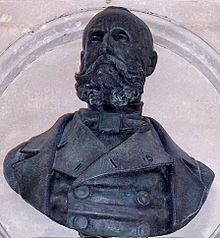Hector Lefuel
Hector Martin Lefuel , also Martin-Hector Lefuel (born November 14, 1810 in Versailles , † December 31, 1880 in Paris ) was a French architect of historicism , whose buildings were mostly in the neo-baroque style.
life and work
The son of the Versailles builder Alexandre Henry Lefuel (1782-1850) was initially trained by this, later by Jean-Nicolas Huyot and from 1829 at the École des Beaux-Arts in Paris. In 1833 he won a "Second Grand Prix" of the Prix de Rome with the project of a military school . Thereupon he returned to Versailles to support his family after the death of his father, but later went back to school. In 1839 he won the “First Grand Prix” of the Prix de Rome with a project for a city hall. This was connected with a scholarship: from 1840 to 1844 Lefuel lived in the Villa Medici in Rome as a scholarship holder .
On his return to Paris, he opened a studio in which he also accepted students, and was appointed building inspector of the Chamber of Deputies. In 1848 he was appointed to the Meudon Castle as an architect . In 1852 he built the Sèvres factory . 1853–1855 he was chief architect of Fontainebleau Castle , where he a. a. built the theater.
As the successor to the late Louis Tullius Visconti , he was in 1854 by Emperor Napoléon III. as chief architect of the Parisian palaces Louvre and Palais des Tuileries , which he should connect and complete. In part, the work was continued according to Visconti's plans, but Lefuel also made significant changes to the floor plans and facades. His work on and around the Louvre includes the Salle des États building , the northern connecting building to the Place du Palais-Royal (with the Treasury and library, opened in 1857), the southern connecting wing ( Galerie du Bord de l'Eau ) with the pavilion Lesdiguères and the Pavillon Trémoille , the renovation of the Pavillon de Flore and several buildings around the Carrousel . For Empress Eugénie , he designed the interior of their private rooms in the Palais des Tuileries. During the uprising of the Paris Commune in 1871, parts of the Louvre were damaged and then restored by Lefuel. However, the completely destroyed Palais des Tuileries was not rebuilt. Lefuel's connecting tracts now form the two outer branches of a courtyard open to the Tuileries Garden.
Lefuel's works also include the Paris city palaces of the Finance Minister Achille Fould (the now demolished Hôtel Fould ) and the museum director Emilien de Nieuwerkerke ( Hôtel de Nieuwerkerke at Parc Monceau ) as well as the Hôtel Émonville in Abbeville . He also designed the tombs of the composers Daniel-François-Esprit Auber and François Bazin in the Père Lachaise cemetery . For the Paris World Exhibition of 1855 he built the provisional Palais des Beaux-Arts et de l'Industrie (Palace of Fine Arts and Industry).
His reputation as an imperial architect earned him the contract to build the new castle (1868-1876) who later Oberschlesisches Versailles -called castle Neudeck one.
Honors
In 1854 Lefuel was made a Knight of the Legion of Honor (1857 officer, 1867 "Commandeur" of the same). In 1855 he succeeded Martin Gauthier as a member of the Académie des Beaux-Arts .
literature
- Françoise Heilbrun, Geneviève Bresc-Bautier: Le photographe et l'architecte. Edouard Baldus, Hector-Martin Lefuel et le chantier du nouveau Louvre de Napoléon III . (Exhibition catalog). Réunion des musées nationaux, Paris 1995, ISBN 2-7118-3245-7
Web links
- Hector Lefuel. In: Structurae
- Literature by and about Hector Lefuel in the SUDOC catalog (Association of French University Libraries)
| personal data | |
|---|---|
| SURNAME | Lefuel, Hector |
| ALTERNATIVE NAMES | Lefuel, Hector Martin; Lefuel, Martin-Hector |
| BRIEF DESCRIPTION | French architect |
| DATE OF BIRTH | November 14, 1810 |
| PLACE OF BIRTH | Versailles |
| DATE OF DEATH | December 31, 1880 |
| Place of death | Paris |



